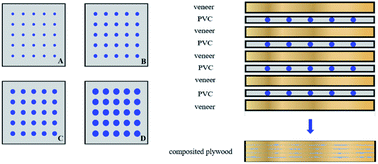Effect of PVC film pretreatment on performance and lamination of wood-plastic composite plywood
Abstract
In order to solve the practical problem of heat transfer during the hot pressing process of a novel wood-plastic composite plywood, this paper investigates the perforation treatment of polyvinyl chloride (PVC) plastic films and their plywood composites. The PVC films were pretreated by the physical punching method, and the effects of PVC perforation diameter, hot pressing time and hot pressing temperature on the mechanical properties of the plywood composites were investigated by orthogonal experimental design. The results showed that the optimum hot pressing time was 7 min, the hot pressing temperature was 170 °C, and the PVC perforation diameter was 15 mm for the optimum mechanical properties. The punching pretreatment of PVC films gave rise to a reduction of the hot pressing time by 51 s due to improved heat transfer and heat loss by 5.06%, and allowed an increase in the initial moisture content of the veneer by 2–3%, thereby cutting down the drying cost in the veneer production process, which is conducive to energy conservation and environmental protection.



 Please wait while we load your content...
Please wait while we load your content...